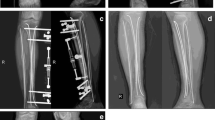Abstract
Purpose
The hypothesis of this study was that lateral minimally invasive plate osteosynthesis (MIPO) would be comparable with medial MIPO with regard to clinical and radiographic results. The purpose of this study was to compare the results of medial and lateral MIPO for treatment of distal tibial fractures.
Materials and methods
Between June 2005 and February 2009, 24 patients with a distal tibia fracture were treated using MIPO. Patients were divided into two groups according to the MIPO methods used; 12 patients were fixated by medial MIPO (group M) and the other 12 patients by lateral MIPO (group L). These two groups were compared with regard to time to union. Clinical results were assessed by use of the IOWA ankle-rating system and the range of ankle motion at last follow-up. Mean operation time and postoperative complications were evaluated by chart review. Radiographic results were assessed on the basis of tibial angulation and shortening at last follow-up.
Results
Radiological evidence of bony union was observed for all study subjects. Mean union time was not significantly different between the two groups. Mean IOWA score, range of ankle motion, and operation time were no different between the two groups. No significant difference in angulation and shortening was observed between the groups, and no patient had an angular deformity >5° or tibial shortening >10 mm at the last follow-up. Skin irritation was encountered in one case in group M and limited motion because of entrapment of the tibialis anterior muscle was observed in one patient in group L.
Conclusion
Both medial and lateral MIPO produced good clinical and radiological results for distal tibial fractures. Lateral MIPO may be an effective option when soft tissue condition on the medial side of the distal tibia is poor or when the fracture line is close to the ankle joint.


Similar content being viewed by others
References
Redfern DJ, Syed SU, Davies SJ. Fractures of the distal tibia: minimally invasive plate osteosynthesis. Injury. 2004;35:615–20.
Anglen JO. Early outcome of hybrid external fixation for fracture of the distal tibia. J Orthop Trauma. 1999;13:92–7.
Fan CY, Chiang CC, Chuang TY, et al. Interlocking nails for displaced metaphyseal fractures of the distal tibia. Injury. 2005;36:669–74.
Fisher WD, Hamblen DL. Problems and pitfalls of compression fixation of long bone fractures: a review of results and complications. Injury. 1978;10:99–107.
Olerud S, Karlstrom G. Tibial fractures treated by AO compression osteosynthesis. Experiences from a five year material. Acta Orthop Scand Suppl. 1972;140:1–104.
Ruedi TP, Allgower M. The operative treatment of intra-articular fractures of the lower end of the tibia. Clin Orthop Relat Res. 1979;138:105–10.
Borrelli J Jr, Prickett W, Song E, et al. Extraosseous blood supply of the tibia and the effects of different plating techniques: a human cadaveric study. J Orthop Trauma. 2002;16:691–5.
Borg T, Larsson S, Lindsjo U. Percutaneous plating of distal tibial fractures. Preliminary results in 21 patients. Injury. 2004;35:608–14.
Ghera S, Santori FS, Calderaro M, et al. Minimally invasive plate osteosynthesis in distal tibial fractures: pitfalls and surgical guidelines. Orthopedics. 2004;27:903–5.
Helfet DL, Suk M. Minimally invasive percutaneous plate osteosynthesis of fractures of the distal tibia. Instr Course Lect. 2004;53:471–5.
Oh CW, Kyung HS, Park IH, et al. Distal tibia metaphyseal fractures treated by percutaneous plate osteosynthesis. Clin Orthop Relat Res. 2003;408:286–91.
Sohn OJ, Kang DH. Staged protocol in treatment of open distal tibia fracture: using lateral MIPO. Clin Orthop Surg. 2011;3:69–76.
Merchant TC, Dietz FR. Long-term follow-up after fractures of the tibial and fibular shafts. J Bone Joint Surg Am. 1989;71:599–606.
Milner SA. A more accurate method of measurement of angulation after fractures of the tibia. J Bone Joint Surg Br. 1997;79:972–4.
Landis JR, Koch GG. The measurement of observer agreement for categorical data. Biometrics. 1977;33:159–74.
Ronga M, Shanmugam C, Longo UG, et al. Minimally invasive osteosynthesis of distal tibial fractures using locking plates. Orthop Clin N Am. 2009;40:499–504, ix.
Wolinsky P, Lee M. The distal approach for anterolateral plate fixation of the tibia: an anatomic study. J Orthop Trauma. 2008;22:404–7.
Conflict of interest
The authors have no conflicts of interest to declare.
Author information
Authors and Affiliations
Corresponding author
About this article
Cite this article
Shon, Oj., Park, Ch. Minimally invasive plate osteosynthesis of distal tibial fractures: a comparison of medial and lateral plating. J Orthop Sci 17, 562–566 (2012). https://doi.org/10.1007/s00776-012-0241-9
Received:
Accepted:
Published:
Issue Date:
DOI: https://doi.org/10.1007/s00776-012-0241-9




